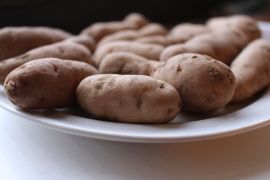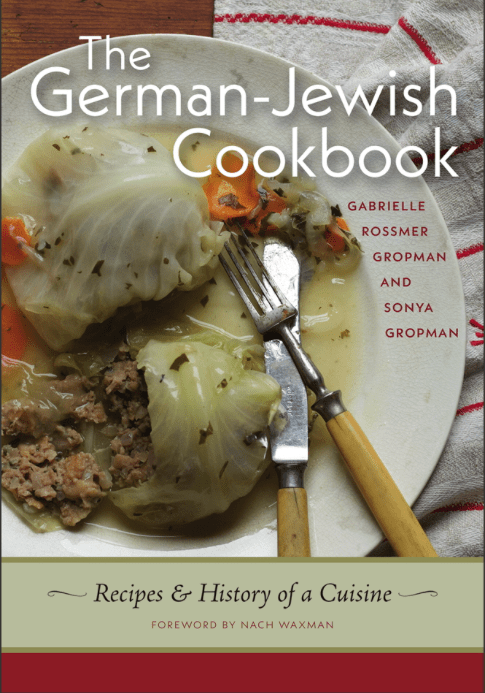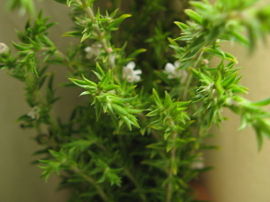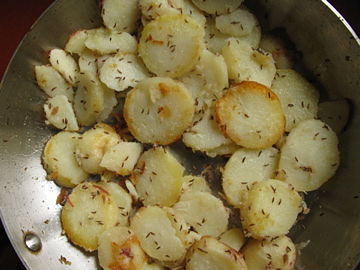
On our recent trip to Bamberg, I stopped by the ObstMarkt in the middle of a plaza in the heart of the Old City (the literal translation is “fruit market”, though vegetables are sold there as well). I wanted to see what types of products might be available in the winter months. There was a wider variety than I expected (at least compared with the farmers’ markets I am accustomed to in my neck of the woods), and I realized that this type of outdoor food market is a combination of a farmers’ market as I know it (one which only sells locally-grown products) and a good-quality produce shop (which sells imported items). As seems to be the norm at German markets, every item had its origin noted on the little price card that sticks out of its crate, and much of the produce seemed to come from other European countries – France, Spain, etc. But in late November, some of the only local items available were these tiny potatoes. They’re so local, in fact, that they are from Bamberg itself!
The Bamberger Hörnla (Bamberg Potato) is a tiny potato with a long history. A small, slender, finger-shaped potato with a thin skin and a waxy, yellow interior, it has been registered by the European Union as a “regional specialty” (the plant, as well as the potato!). In the same way that the name “Champagne” may not be applied to sparkling wine unless the grapes were grown in a specific region of France, in order for a potato to be named a Bamberger Hörnla it must be grown in the Franconian region of Germany. Because it is a low-yield crop, as well as a delicate one, it is not lucrative for farmers to grow. Thus, it is only produced on a small scale, often in home gardens for personal use. This potato is not exported and is generally only available for purchase at local markets.


While Bamberg has a very long agricultural tradition, I only learned recently the full extent of its history as an urban farming city. According to the Slow Food organization — which created a presidium in Bamberg dedicated in 2009 to the Bamberger Hörnla potato (meaning it’s a protected species) — there was a “garden quarter” (Gärtnerviertel) in the Old City dating back to the 14th century. By the middle of the 19th century, there were about 500 urban farmhouses (one third of all the buildings in the city). Each of these had a garden plot of about 1,000 square meters (approximately 1/4 acre) in their backyard where vegetables, herbs, fruit trees and grape vines were grown. Considering my own involvement with, and passion for, supporting local agriculture I am kind of amazed to learn of this agricultural tradition in one of my familial hometowns — the one where both my grandfather and mother were born. It gives me a feeling of continuity. It also throws a different light on imagining the types of fruits and vegetables my great-grandmother may have used in her cooking — both those purchased on her regular shopping trips to this same market that I visited (which perhaps was selling some items that had been growing only a few blocks from her home!), as well as things that grew in her own backyard. While our family were not farmers (they owned a factory that manufactured men’s clothing in Bamberg), they had a large yard that lay between the factory and their apartment building. The garden was a point of pride for the family, a place where they grew fruit trees and roses, among other things.
 I purchased a small sackful of Bamberger Hörnla from a stand at the market. The purveyor made a special point of telling me to cook them with their skins on, and if I wanted to peel them to do so after they were cool enough to handle. It is traditional to use these tasty little potatoes for a potato salad that is dressed with broth and vinaigrette. But since I only had a small amount of them, I decided to make a simple dish of steamed potatoes with butter and parsley.
I purchased a small sackful of Bamberger Hörnla from a stand at the market. The purveyor made a special point of telling me to cook them with their skins on, and if I wanted to peel them to do so after they were cool enough to handle. It is traditional to use these tasty little potatoes for a potato salad that is dressed with broth and vinaigrette. But since I only had a small amount of them, I decided to make a simple dish of steamed potatoes with butter and parsley.


A recipe is hardly needed for this dish, but here are the simple steps. The amounts are variable, but figure on approximately one pound of potatoes for four people, with about one tablespoon of butter, one or two handfuls of chopped parsley, and salt and pepper to taste.
Steamed Potatoes with Butter + Parsley
Potatoes (any will do, but waxy potatoes such as Yukon Gold, red skinned, or new potatoes work well)
Butter, cut into thin pats (at room temperature)
Parsley, chopped
Salt and Pepper
1) Scrub the potatoes. Leave whole, or, if large, cut in half or quarters (trying to keep the pieces the same size).
2) Steam the potatoes in a steamer basket for 10-15 minutes, or until a fork easily pierces the flesh.
3) (Optional: If desired, peel potatoes when they are cool enough to handle, but still warm.)
3) Put potatoes in a serving dish. Add pats of butter, salt, pepper, and parsley. Toss gently. Serve




































